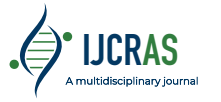| Title: HEALTH RISK ASSESSMENT OF SOME HEAVY METALS (CADMIUM, CHROMIUM AND LEAD) IN COMMONLY CONSUMED VEGETABLES, COLLECTED AT JANGUZA MARKET, KANO STATE, NIGERIA |
|
Author: B.I. Hafsat, T.S. Imam and U. Bawa |
|
Abstract: Heavy metals contamination of commonly consumed vegetables is a major global concern to human health. The consumption of contaminated vegetables is a major route of heavy metals ingestion to human body system. This project research was to assess the health risk of some heavy metals (cadmium, chromium and lead) in commonly consumed vegetables; Bitter leaf (Vernonia amygdalina), Cucumber (Cucumis sativus), Tomato (Solanum lycopersicum), Lettuce (Lactuca sativa), Pumpkin (Cucurbita pepo), Okra (Abelmoschus esculentus), Spinach (Spinacia oleracea), and Cabbage (Brassica oleracea), collected at Janguza market, Kano state, Nigeria. The Samples of vegetables were collected, air dried, digested and analyzed for heavy metals concentrations through atomic absorption spectrophotometer. The result obtained revealed that Cadmium, chromium and lead concentrations in the sampled vegetables ranged from (0.012-0.077) mg/kg, (0.004-0.046) mg/kg, (0.008-0.018) mg/kg, respectively. spinach had the highest concentration for cadmium (0.077) mg/kg and chromium (0.046) mg/kg, while tomato had the highest concentration for lead (0.018) mg/kg. The mean concentration of heavy metals in all the investigated vegetables were below the permissible limits set by WHO, 2007. The computed health risk indices of hazard quotient, hazard index and Daily intake of metals through adult consumption of the investigated vegetables do not pose any potential risk to human health. It is recommended that researches should be carried out to ascertain the sources of contamination of these heavy metals in commonly consumed vegetables in Kano state so as to reduce the potential health risk through the consumption of these vegetables. |
| Keywords: Heavy metals, Health risk, Hazard Quotient, Hazard index. |
| PDF Download |
International Journal of Current Research and Applied Studies
An open access multidisciplinary journal, ISSN 2583-6781
